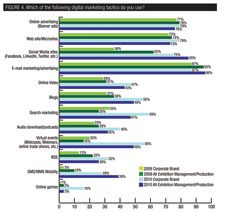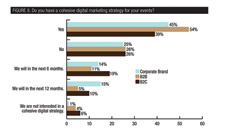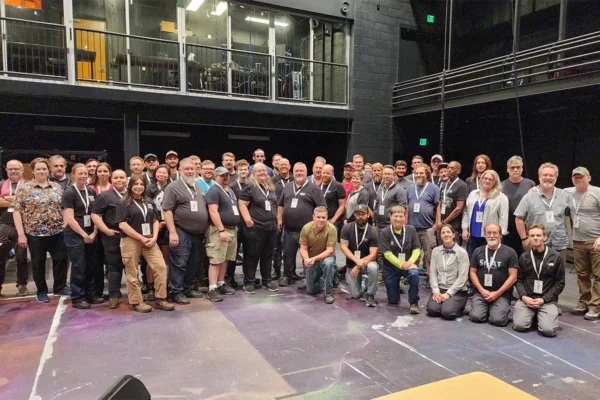
Depending on what definition is used, social media has been around since instant messaging was introduced in 1996. In 2004, MySpace and Facebook went online, followed by Twitter in 2007.
Soon after, the social network exploded and social media became a part of everyday life. Similar to the big bang, the digital and social media explosion has been expanding in all directions and it appears the shock wave is about to travel directly through the tradeshow, convention and specialty meetings industry.
New research from the Center for Exhibition Industry Research (CEIR) and George P. Johnson Experience Marketing (GPJ) suggests that brand marketers and exhibition organizers are using an increasingly broad array of digital media to add value to their exhibition and create richer experiences for their audiences.
The Digital + Exhibit Marketing Insights study surveyed the opinions of 265 exhibition marketing professionals, including corporate brand exhibitors and exhibition management executives with the goal of providing insight into the impact of digital media on exhibition performance.
“Exhibition marketers have been increasingly leveraging digital media to enhance the value of their events, facilitate partner networking and promote their products and services,” said Cathy Breden, CAE, CMP, CEIR executive director. “However, this data suggests that a much deeper and broader change is sweeping the exhibit marketing industry, with players at every level making a real commitment to digital adoption.”
Co-produced by The Jordan Edmiston Group and with the support of the Event Marketing Institute, the report was created to help the exhibition industry make better decisions about deploying digital, social and virtual media as crucial components of modern exhibit portfolios.
Now in its second year, this unique research program confirms that tradeshow professionals are leading the charge to integrate digital into nearly every aspect of pre-show promotion, onsite interaction and post-event sales fulfillment.
“Social communications are proving to be a rapid-deployment toolset that can improve results and return-on-investment (ROI),” said David Rich, GPJ senior vice president of Program Strategy/Worldwide. “Having an experience marketing strategy with a well thought out digital strategy is a crucial aspect of tradeshow marketing, especially in terms of developing creative ideas, messaging and brand experiences.”

Results from the survey suggest that social media will eventually penetrate every aspect of the show cycle. Of the 265 respondents, 72 percent expect to have digital event strategies in place by the end of the year.
Those strategies include online ads and e-mail marketing prior to the event, text messaging platforms during the event and content downloads available after the event.
Exhibition management and corporate brand-side marketers are also looking to explore the cost efficiencies afforded by online media.
Social media was seen by 47 percent of those surveyed as providing significant ROI in the promotion of an event, however, 69 percent of respondents did not have the means to measure its impact.
“Understanding the level of impact social media and virtual events has on our event and exhibition performance is something we’re looking at very closely right now,” said Christine Jacobs, North America demand program leader, digital marketing for IBM. “The prevalence of the smart phone has certainly increased the level of participation in social media on site. One big challenge, in particular, is assigning value to the qualitative aspects of this medium.”
Even without a clear understanding of how to measure social media ROI, 78 percent of respondents believe that digital marketing increases exhibition effectiveness.
Others have already witnessed the power of the social network.
“The digital medium has already proven to be most effective in terms of market penetration and cost containment for overall marketing strategies,” said Brian Casey, CEM, president and CEO of High Point Market Authority. “High Point’s marketing program, for some time, has embraced a strong social media component, as well as more customized and highly targeted communications that can reach directly into the hearts and minds of the customers we seek to engage.”
This viewport seems to be shared throughout the industry, as no respondent indicated that social media has a negative impact on their promotions.
“There is no question that digital marketing is a critical component of our marketing mix,” said Nancy Hasselback, president & CEO of Diversified Business Communications. “For some of our events, we can attribute up to 25 percent of our attendees directly to our email marketing.”
In fact, 85 percent cited e-mail marketing as the preferred tactic that provides the greatest ROI in the marketing of an event.
Regardless of what marketing tactic is used, the digital and social media explosion will continue to expand through the tradeshow industry.
Almost 45 percent of those surveyed intend to increase their digital marketing staff and 40 percent indicated that digital marketing already makes up 10 percent of their exhibition budget.
Almost 15 years after social media was introduced to the world and only a few years since Facebook and Twitter took center stage, digital and social media is digging its claws deeper and deeper into the exhibition industry, and like the initial explosion, this one is showing no signs of slowing down.
Other key findings from this year’s research include
• For 27 percent of respondents, digital marketing decisions are made by a resident digital expert within their company’s event marketing function.
• Measurement of digital’s impact on exhibition performance is significant but not yet a best practice among those surveyed, with only 43 percent measuring these activities.
• The digital tactics respondents most frequently integrate into their event promotion lifecycle include online advertising, 48 percent, and e-mail, 39 percent pre-event; text messaging, 41percent during the event; audio downloads, 40 percent, post-event; and RSS feeds, 57 percent throughout.
• Sixty-one percent of respondents use virtual events, inclusive of webcasts and webinars, as well as 2D/3D simulated tradeshow environments, to complement live events.
• Forty-six percent of respondents report increasing the use of digital marketing in event promotion over the past year; 78 percent believe digital marketing increases the effectiveness of exhibition promotion.
• The leading motivators for exhibition and event marketers to integrate digital marketing into their event marketing promotional plans are to drive awareness, 71percent; extend reach, 70 percent, and increase event attendance, 61percent.
• The exhibition community views social media as a lower-cost event promotion tool rather than a sales enablement medium.
Now what?
According to the study, successful marketers will continue to incorporate digital media into their exhibition marketing formulas, focusing on the strategies and tactics that enhance performance. Producers will continue to experiment with digital media to figure out how to use it to differentiate their brands and serve the changing needs of their audiences.
The key to success for both groups in regards to the adoption of digital and social media lies in collaboration.
Recommendations based on the data from this report
• Conduct research into audience attitude and understanding of technographics.
• Attain a deeper understanding of how audiences use social networks, mobile technology, blogs, Twitter, and other digital tactics to create a more specific and effective digital strategy.
• Audit internal and partner digital capabilities and understanding.
• Work to identify the right talent internally and externally to make better use of your resources and capabilities, as well as fill key knowledge and investment gaps.
• Institute more rigorous measurement of digital tactics.
• Use data to measure digital’s impact and ROI, whether you start small and grow or embrace a comprehensive measurement model.
• Operate from an understanding of digital as both a promotional and sales tool.
• Go deeper into the data and require further exploration of these topics.
View the entire CEIR Digital + Exhibiting Marketing Insights 2010 report
| Home |
| People on the Move |
| National News |
| Regional News |
| Features |
| Tradeshow Calendar |





























